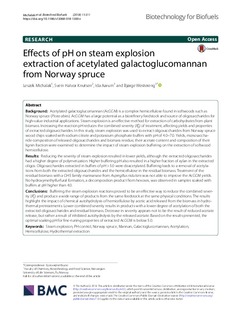| dc.contributor.author | Michalak, Leszek | |
| dc.contributor.author | Knutsen, Svein Halvor | |
| dc.contributor.author | Aarum, Ida Synnøve | |
| dc.contributor.author | Westereng, Bjørge | |
| dc.date.accessioned | 2019-02-19T09:02:18Z | |
| dc.date.available | 2019-02-19T09:02:18Z | |
| dc.date.created | 2018-12-04T12:28:31Z | |
| dc.date.issued | 2018 | |
| dc.identifier.citation | Biotechnology for Biofuels. 2018, 11 (311), 1-12. | |
| dc.identifier.issn | 1754-6834 | |
| dc.identifier.uri | http://hdl.handle.net/11250/2586124 | |
| dc.description.abstract | Background: Acetylated galactoglucomannan (AcGGM) is a complex hemicellulose found in softwoods such as Norway spruce (Picea abies). AcGGM has a large potential as a biorefinery feedstock and source of oligosaccharides for high-value industrial applications. Steam explosion is an effective method for extraction of carbohydrates from plant biomass. Increasing the reaction pH reduces the combined severity ( R′ 0 ) of treatment, affecting yields and properties of extracted oligosaccharides. In this study, steam explosion was used to extract oligosaccharides from Norway spruce wood chips soaked with sodium citrate and potassium phosphate buffers with pH of 4.0–7.0. Yields, monosaccharide composition of released oligosaccharides and biomass residue, their acetate content and composition of their lignin fraction were examined to determine the impact of steam explosion buffering on the extraction of softwood hemicellulose. Results: Reducing the severity of steam explosion resulted in lower yields, although the extracted oligosaccharides had a higher degree of polymerization. Higher buffering pH also resulted in a higher fraction of xylan in the extracted oligos. Oligosaccharides extracted in buffers of pH > 5.0 were deacetylated. Buffering leads to a removal of acetylations from both the extracted oligosaccharides and the hemicellulose in the residual biomass. Treatment of the residual biomass with a GH5 family mannanase from Aspergillus nidulans was not able to improve the AcGGM yields. No hydroxymethylfurfural formation, a decomposition product from hexoses, was observed in samples soaked with buffers at pH higher than 4.0. Conclusions: Buffering the steam explosion reactions proved to be an effective way to reduce the combined severity ( R′ 0 ) and produce a wide range of products from the same feedstock at the same physical conditions. The results highlight the impact of chemical autohydrolysis of hemicellulose by acetic acid released from the biomass in hydrothermal pretreatments. Lower combined severity results in products with a lower degree of acetylation of both the extracted oligosaccharides and residual biomass. Decrease in severity appears not to be the result of reduced acetate release, but rather a result of inhibited autohydrolysis by the released acetate. Based on the results presented, the optimal soaking pH for fine-tuning properties of extracted AcGGM is below 5.0. | |
| dc.description.abstract | Effects of pH on steam explosion extraction of acetylated galactoglucomannan from Norway spruce | |
| dc.language.iso | eng | |
| dc.subject | Mannan | |
| dc.subject | Galactoglucomannan | |
| dc.subject | Steam explosion | |
| dc.subject | Gran | |
| dc.subject | Norway spruce | |
| dc.subject | PC control | |
| dc.title | Effects of pH on steam explosion extraction of acetylated galactoglucomannan from Norway spruce | |
| dc.type | Peer reviewed | |
| dc.type | Journal article | |
| dc.description.version | publishedVersion | |
| dc.source.pagenumber | 1-12 | |
| dc.source.volume | 11 | |
| dc.source.journal | Biotechnology for Biofuels | |
| dc.source.issue | 311 | |
| dc.identifier.doi | 10.1186/s13068-018-1300-z | |
| dc.identifier.cristin | 1638924 | |
| dc.relation.project | Norges forskningsråd: 208674/F50 | |
| dc.relation.project | Norges forskningsråd: 243950 | |
| dc.relation.project | Norges forskningsråd: 270038 | |
| dc.relation.project | Nofima AS: 11205 | |
| dc.relation.project | Norges forskningsråd: 244259 | |
| cristin.unitcode | 7543,3,1,0 | |
| cristin.unitname | Mat og helse | |
| cristin.ispublished | true | |
| cristin.fulltext | original | |
| cristin.qualitycode | 1 | |
